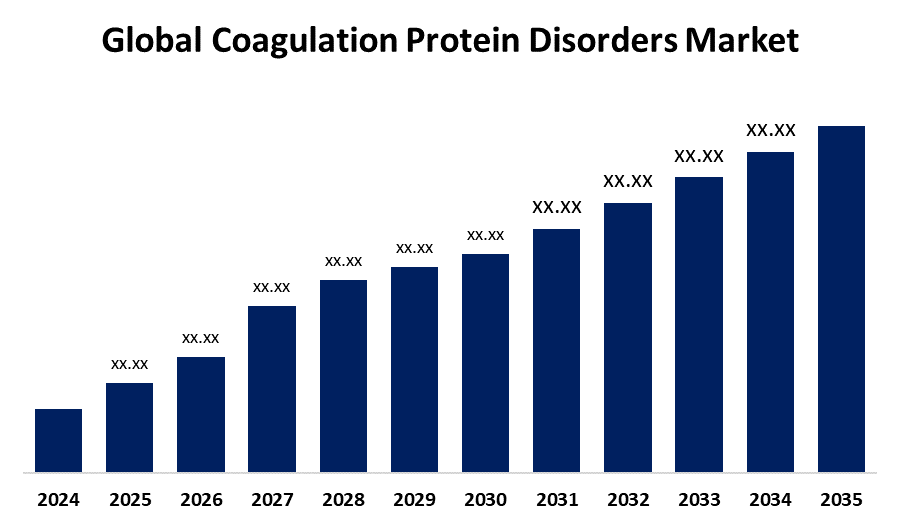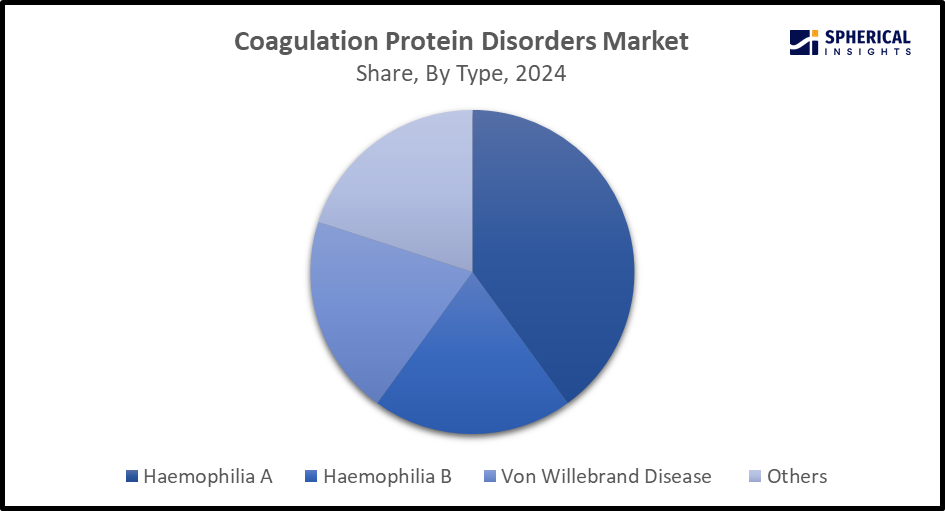Global Coagulation Protein Disorders Market Size, Share, and COVID-19 Impact Analysis, Russia-Ukraine War Impact, Tariff Analysis, By Type (Haemophilia A, Haemophilia B, Von Willebrand Disease, and Others), By End-user (Hospitals, Specialty Clinics, Diagnostic Centers, and Blood Banks), By Region (North America, Europe, Asia-Pacific, Latin America, Middle East, and Africa), Analysis and Forecast 2025 - 2035
Industry: HealthcareGlobal Coagulation Protein Disorders Market Insights Forecasts to 2035
- The Market Size is Expected to Grow at a CAGR of around 7.22% from 2025 to 2035
- The Worldwide Coagulation Protein Disorders Market Size is Expected to hold a significant share by 2035
- Asia Pacific is expected to grow the fastest during the forecast period.

Get more details on this report -
According to a research report published by Spherical Insights and Consulting, The Global Coagulation Protein Disorders Market Size is predicted to hold a significant share by 2035 with a compound annual growth rate (CAGR) of 7.22 % from 2025 to 2035. Coagulation protein disorder is associated with the levels and functionality of various clotting factors like von Willebrand factor, factor VIII, factor IX, and others. It is anticipated that the increasing prevalence of bleeding disorders, biotechnology advancements, and emphasis on research and development activities are primarily supporting the market of coagulation protein disorders.
Global Coagulation Protein Disorders Market Forecast and Revenue Outlook
- CAGR (2025-2035): 7.22%
- North America: Largest market in 2024
- Asia Pacific: Fastest growing market
Market Overview
The coagulation protein disorders market is the industry associated with the diagnosis, treatment, and management of conditions caused by abnormalities in blood-clotting proteins, like haemophilia and Von Willebrand disease. Coagulation disorders are conditions affecting the body's control over blood clotting, which means the body forms too many or too few blood clots. Coagulation proteins are involved in coagulation mechanisms, including the sealing of small blood vessels during hemostasis, undergoing a process of denaturation and aggregation, which results in the formation of a solid or semi-solid state. Genetic testing is performed to identify the specific gene mutations responsible for the coagulation protein disorders. Factor replacement therapy, antifibrinolytic agents, and desmopressin are several effective treatment regimes that are increasingly used to manage bleeding risk and improve patients’ quality of life.
The global market share is anticipated to be supported by expanding R&D efforts and strategic partnerships by major industry participants, such as Pfizer, Takeda & Poseida Therapeutics for developing next-generation therapies and leveraging relevant experience from external experts, especially for complex technologies. There are opportunities in the developing market due to the growing healthcare infrastructure and biotechnological innovation for effective and safer therapies. For instance, in September 2025, VarmX, a biotech company, entered into a strategic collaboration with biotechnology leader CSL to support the development of a novel treatment approach, VMX-C001, for restoring blood coagulation in patients requiring urgent surgery or experiencing severe bleeding while on FXa DOACs.
Key Market Insights
- North America is expected to account for the largest share in the coagulation protein disorders market during the forecast period.
- In terms of type, the haemophilia A segment captured the largest portion of the market.
- In terms of end-user, the hospitals segment is projected to lead the Coagulation Protein Disorders Market throughout the forecast period.
Coagulation Protein Disorders Market Trends
- Advancements in genetic and personalized medicine by the use of next-generation sequencing
- Technological advancement in blood coagulation monitoring for POC diagnostic testing
- Use of sophisticated diagnostic tools such as AI-powered platforms and telemedicine for enhancing care accessibility
- Advanced assays and chromogenic tests for improving the detection of specific coagulation factors and aiding in differentiating bleeding and thrombotic disorders
Report Coverage
This research report categorizes the coagulation protein disorders market based on various segments and regions, forecasts revenue growth, and analyzes trends in each submarket. The report analyzes the key growth drivers, opportunities, and challenges influencing the Coagulation Protein Disorders Market. Recent market developments and competitive strategies, such as expansion, type launch, development, partnership, merger, and acquisition, have been included to draw the competitive landscape in the market. The report strategically identifies and profiles the key market players and analyzes their core competencies in each sub-segment of the coagulation protein disorders market.
Coagulation Protein Disorders Market Report Coverage
| Report Coverage | Details |
|---|---|
| Base Year: | 2024 |
| Forecast Period: | 2025-2035 |
| Forecast Period CAGR 2025-2035 : | 7.25 % |
| Historical Data for: | 2020-2023 |
| No. of Pages: | 240 |
| Tables, Charts & Figures: | 122 |
| Segments covered: | By Type, By End-user, By Region |
| Companies covered:: | Bioverativ, Takeda, Chugai Pharmaceutical, CSL, Bayer HealthCare, Pfizer, Novo Nordisk, Others |
| Pitfalls & Challenges: | COVID-19 Empact, Challenges, Future, Growth, & Analysis |
Get more details on this report -
Driving factors
The coagulation protein disorders market is driven by the increasing prevalence of bleeding disorders, including inherited coagulation protein disorders, most commonly Haemophilia A and Haemophilia B. Biotechnology advancements and increasing research and development activities focusing on gene therapy and novel recombinant factor replacement therapies are propelling the market growth. Further, increasing regulatory approvals for treatment and healthcare accessibility are contributing to promoting market growth.
Restraining Factor
One of the main factors restraining the coagulation protein disorders market is the increased cost of recombinant therapies, limiting their adoption in emerging economies. Further, the imposition of strict regulations and the lack of reimbursement policies associated with the treatment are hampering the market growth.
Market Segmentation
The global coagulation protein disorders market is divided into type and end-user.
Global Coagulation Protein Disorders Market, By Type:
- The haemophilia A segment dominated the market with a major revenue share in 2024 and is projected to grow at a substantial CAGR during the forecast period.
Based on type, the global coagulation protein disorders market is segmented into haemophilia A, haemophilia B, Von Willebrand disease, and others. Among these, the haemophilia A segment dominated the market with a major revenue share in 2024 and is projected to grow at a substantial CAGR during the forecast period. Haemophilia A is characterized by a deficiency or defective production of blood-clotting factor VIII, which is required for clot formation. An increasing demand for hemostatic agents, such as antifibrinolytic agents, as adjunctive therapy to enhance clot stability and minimize bleeding, is contributing to propel market demand.

Get more details on this report -
The Von Willebrand disease segment is anticipated to grow at a significant CAGR during the projected period, owing to the growing prevalence of Von Willebrand disease and the advancement in coagulation disorder diagnostics, including genetic testing. Von Willebrand disease is caused by the dysfunction of von Willebrand protein factor, involved in blood clotting.
Global Coagulation Protein Disorders Market, By End-user:
- The hospitals segment accounted for the dominant share in 2024 and is anticipated to grow at a significant CAGR during the forecast period.
Based on end user, the global coagulation protein disorders market is segmented into hospitals, specialty clinics, diagnostic centers, and blood banks. Among these, the hospitals segment accounted for the dominant share in 2024 and is anticipated to grow at a significant CAGR during the forecast period. Advancements in medical technology are encouraging the development of enhanced diagnostic-capable solutions in hospitals. The increasing collaboration between key players and hospitals is contributing to driving the market growth in the hospitals segment.
The diagnostic centers segment is anticipated to grow at a substantial CAGR during the forecast period, due to increasing awareness about blood-related disorders and patient demand for timely and accurate diagnostic services. Further, the improvement in diagnostic capabilities with an increasing prevalence of disorders, including haemophilia and von Willebrand disease, is enhancing the market demand.
Regional Segment Analysis of the Global Coagulation Protein Disorders Market
- North America (U.S., Canada, Mexico)
- Europe (Germany, France, U.K., Italy, Spain, Rest of Europe)
- Asia-Pacific (China, Japan, India, Rest of APAC)
- South America (Brazil and the Rest of South America)
- The Middle East and Africa (UAE, South Africa, Rest of MEA)
North America Coagulation Protein Disorders Market Trends

Get more details on this report -
North America is expected to hold the largest share of the global coagulation protein disorders market over the forecast period.
The growing cases of von Willebrand disease and other bleeding disorders, along with an increasing age-related conditions affecting blood clotting, are contributing to driving the market demand. Further, the presence of strong healthcare infrastructure and technological advancements in treatment modalities is enhancing the coagulation protein disorders market.
U.S. Coagulation Protein Disorders Market Trends
U.S. holds the largest portion of the coagulation protein disorders market in the North America region, due to the presence of a large patient pool and treatment modalities. Further, the region’s favourable reimbursement policies for treatment of coagulation protein disorders like haemophilia encourage patients to seek medical help.
Asia Pacific Coagulation Protein Disorders Market Trends
Asia Pacific is expected to grow at a significant CAGR in the coagulation protein disorders market during the forecast period. In the Asia Pacific market, the increasing demand for early diagnosis and treatment with a rising prevalence of blood disorders is propelling the market growth. An increasing investment in developing diagnostic solutions for treating coagulation disorders significantly contributes to market growth.
China Coagulation Protein Disorders Market Trends
China’s vast patient pool and ongoing healthcare reforms are vital factors responsible for market growth. An increasing government initiatives that emphasize increasing awareness and diagnosis of coagulation disorders are supporting the market growth.
Competitive Analysis:
The report offers the appropriate analysis of the key organizations/companies involved within the global coagulation protein disorders market, along with a comparative evaluation primarily based on their type of offering, business overviews, geographic presence, enterprise strategies, segment market share, and SWOT analysis. The report also provides an elaborate analysis focusing on the current news and developments of the companies, which includes type development, innovations, joint ventures, partnerships, mergers & acquisitions, strategic alliances, and others. This allows for the evaluation of the overall competition within the market.
Global Top Key Players In The Coagulation Protein Disorders Market Include
- Bioverativ
- Takeda
- Chugai Pharmaceutical
- CSL
- Bayer HealthCare
- Pfizer
- Novo Nordisk
- Others
Key Target Audience
- Market Players
- Investors
- End-users
- Government Authorities
- Consulting And Research Firm
- Venture capitalists
- Value-Added Resellers (VARs)
Recent development
- In May 2025, CRISPR Therapeutics, a biopharmaceutical company, and Sirius Therapeutics, a clinical-stage biotech company, announced a strategic partnership to develop and commercialize siRNA therapies. SRSD107 is a next-generation, long-acting siRNA designed to selectively inhibit Factor XI (FXI), a key driver of pathological thrombosis with minimal impact on normal hemostasis.
- In October 2024, Pfizer Inc., announced that the U.S. FDA has approved HYMPAVZI (marstacimab-hncq) for routine prophylaxis to prevent or reduce the frequency of bleeding episodes in adults and pediatric patients 12 years of age and older with hemophilia A (congenital factor VIII deficiency) without factor VIII (FVIII) inhibitors, or hemophilia B (congenital factor IX deficiency) without factor IX (FIX) inhibitors.
Market Segment
This study forecasts revenue at the global, regional, and country levels from 2020 to 2035. Spherical Insights has segmented the Coagulation Protein Disorders Market based on the following segments:
Global Coagulation Protein Disorders Market, By Type
- Haemophilia A
- Haemophilia B
- Von Willebrand Disease
- Others
Global Coagulation Protein Disorders Market, By End-User
- Hospitals
- Specialty Clinics
- Diagnostic Centers
- Blood Banks
Global Coagulation Protein Disorders Market, By Regional Analysis
- North America
- US
- Canada
- Mexico
- Europe
- Germany
- UK
- France
- Italy
- Spain
- Russia
- Rest of Europe
- Asia Pacific
- China
- Japan
- India
- South Korea
- Australia
- Rest of Asia Pacific
- South America
- Brazil
- Argentina
- Rest of South America
- Middle East & Africa
- UAE
- Saudi Arabia
- Qatar
- South Africa
- Rest of the Middle East & Africa
Frequently Asked Questions (FAQ)
-
1. Which region holds the largest share of the coagulation protein disorders market?North America is anticipated to hold the largest share of the coagulation protein disorders market over the predicted timeframe.
-
2. What is the forecasted CAGR of the Global Coagulation Protein Disorders Market from 2024 to 2035?The market is expected to grow at a CAGR of around 7.22% during the period 2024–2035.
-
3. Who are the top companies operating in the Global Coagulation Protein Disorders Market?Key players include Bioverativ, Takeda, Chugai Pharmaceutical, CSL, Bayer HealthCare, Pfizer, and Novo Nordisk.
-
4. Can you provide company profiles for the leading coagulation protein disorders manufacturers?Yes. For example, Bioverativ is an American multinational biotechnology company that specializes in the discovery, development, and delivery of therapies for the treatment of haemophilia. Takeda is a pharmaceutical company primarily engaged in the research, development, production, and commercialization of biopharmaceutical products.
-
5. What are the main drivers of growth in the coagulation protein disorders market?An increasing prevalence of bleeding disorders, biotechnology advancements, and emphasis on research and development activities are major market growth drivers of the coagulation protein disorders market.
-
6. What challenges are limiting the coagulation protein disorders market?An increased therapy cost, as well as a lack of reimbursement policies and stringent regulations associated with the treatment, remain key restraints in the coagulation protein disorders market.
-
7. How are recent innovations impacting the coagulation protein disorders market?7. How are recent innovations impacting the coagulation protein disorders market? Recent innovations, including the development of gene therapies, RNA-based therapies, and bispecific antibodies, are positively impacting the coagulation protein disorders market.
Need help to buy this report?